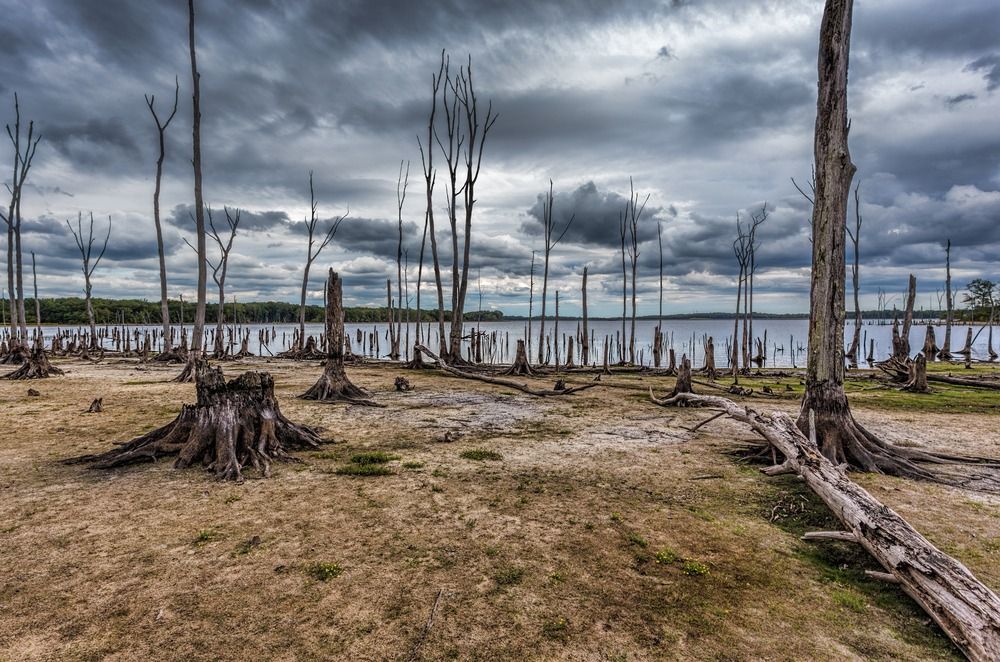Climate report understates threat
By Mario Molina, Veerabhadran Ramanathan, Durwood J. Zaelke | October 9, 2018
 Image courtesy of Shutterstock
Image courtesy of Shutterstock
The UN’s Intergovernmental Panel on Climate Change’s Special Report on Global Warming of 1.5 degrees Celsius, released on Monday, is a major advance over previous efforts to alert world leaders and citizens to the growing climate risk. But the report, dire as it is, misses a key point: Self-reinforcing feedbacks and tipping points—the wildcards of the climate system—could cause the climate to destabilize even further. The report also fails to discuss the five percent risk that even existing levels of climate pollution, if continued unchecked, could lead to runaway warming—the so-called “fat tail” risk. These omissions may mislead world leaders into thinking they have more time to address the climate crisis, when in fact immediate actions are needed. To put it bluntly, there is a significant risk of self-reinforcing climate feedback loops pushing the planet into chaos beyond human control.
The report does describe how much more serious climatic impacts will be if the world lets warming reach 2 degrees Celsius above pre-industrial levels. Limiting the warming to 1.5 degrees Celsius can, for example, cut many impacts in half, including those of fresh water shortage and losses of many species and of ocean fish catch. The report is relatively optimistic that this can be done, but only with unprecedented commitment and cooperation from governments, industry, religious and secular leaders, and citizens around the world.
So far, average temperatures have risen by one degree Celsius. Adding 50 percent more warming to reach 1.5 degrees won’t simply increase impacts by the same percentage—bad as that would be. Instead, it risks setting up feedbacks that could fall like dangerous dominos, fundamentally destabilizing the planet. This is analyzed in a recent study showing that the window to prevent runaway climate change and a “hot house” super-heated planet is closing much faster than previously understood.
These cascading feedbacks include the loss of the Arctic’s sea ice, which could disappear entirely in summer in the next 15 years. The ice serves as a shield, reflecting heat back into the atmosphere, but is increasingly being melted into water that absorbs heat instead. Losing the ice would tremendously increase the Arctic’s warming, which is already at least twice the global average rate. This, in turn, would accelerate the collapse of permafrost, releasing its ancient stores of methane, a super climate pollutant 30 times more potent in causing warming than carbon dioxide.
By largely ignoring such feedbacks, the IPCC report fails to adequately warn leaders about the cluster of six similar climate tipping points that could be crossed between today’s temperature and an increase to 1.5 degrees—let alone nearly another dozen tipping points between 1.5 and 2 degrees. These wildcards could very likely push the climate system beyond human ability to control. As the UN Secretary General reminded world leaders last month, “We face an existential threat. Climate change is moving faster than we are.… If we do not change course by 2020, we risk missing the point where we can avoid runaway climate change, with disastrous consequences….”
The IPCC report makes clear for the first time that limiting warming to 1.5 degrees requires cutting short-lived super climate pollutions—black carbon, methane, and hydrofluorocarbons—along with carbon dioxide, as well as learning how to pull carbon dioxide out of the atmosphere at scale.
The report notes that there are historic precedents for the speed we need, although not for the scale of required mitigation. But the United States’ World War II industrial mobilization provides an encouraging precedent: Only three-and-a-half years elapsed between Pearl Harbor and D-Day. Our economies have a remarkable ability to adapt quickly with the right policies. So neither fatalism nor despair are warranted, but rather a sense of urgent, or even running-scared, optimism.
Governor Jerry Brown’s Global Climate Action Summit in San Francisco last month teamed up with technology innovators, zero-carbon energy producers, entrepreneurs, and other optimists to seize this challenge. President Macron’s One Planet Summit followed in New York during Climate Week, bringing together leaders of finance who were optimistic that managing climate risk is not only possible, but an exciting challenge that would also be profitable as new industries arise to do the most important work the world has ever demanded. (One estimate of the cost of carbon dioxide removal is a staggering $89 to $535 trillion this century—a sizable new market.)
It is critical that world leaders understand the IPCC report and use it as a template for immediate action. While its approaches have been identified before—including last year’s Well Under 2C study that we co-chaired with over 30 experts—the IPCC report should be a rallying point for nations to implement the policies needed to limit global warming to no more than 1.5 degrees Celsius.
Climate change should not be a divisive political issue. It is an issue of fundamental, data-driven science, an issue of human tragedy, and an issue of planetary ecosystems in peril. But above all, it is an issue we can still do something about.
Changing course will take leadership, such as we have seen in the United States from Governor Brown and the cities and states in his coalition, and from key heads of state such as China’s President Xi and India’s Prime Minister Modi, as well as France’s President Macron. These three leaders have the potential to provide Churchillian leadership to stabilize the world’s climate, starting by rallying the G20 countries responsible for 80 percent of the problem. They’ll need to speed up, and scale up, to succeed.
Together, we make the world safer.
The Bulletin elevates expert voices above the noise. But as an independent nonprofit organization, our operations depend on the support of readers like you. Help us continue to deliver quality journalism that holds leaders accountable. Your support of our work at any level is important. In return, we promise our coverage will be understandable, influential, vigilant, solution-oriented, and fair-minded. Together we can make a difference.
Keywords: climate, climate change, global warming
Topics: Analysis, Climate Change


















Thank you for great article. FYI it’s ‘Intergovernmental’ not ‘International’
This article is in accordance with what Steven Hawking warned: that we pose one of the greatest existential threats to ourselves. The comic book character Pogo said it before: “We have met the enemy and he is us”. This is a deeply systemic problem involving no less than dealing with warped human cognitive patterns on an individual and global scale. Good luck.
I can’t see there is the will amongst the political leaders to see this through,therefore I feel we are heading for disaster. Society as whole has to change.
Exactly – I’m an earth scientist as well and ended up becoming a sustainability consultant, lecturer and ecopreneur. I founded an initiative called http://www.oneplanetkitchen.org which seeks to address the consumptive nature of humanity and by encouraging a sustainable lifestyle we could literally eat our way out of this problem by consuming more locally, organic and veggie. Doing so would cut emissions in half! I’m talking ALL emissions effectively, think about all the emissions coming from animal agriculture, importation of food, feed, fertiliser, chemicals etc. The moment you enable the circular economy and consume within your local context at an organic… Read more »
It is often said that there is not enough political will or that industries with vested interests lobby hard to lower the priority of combating climate change yet, if you look statistically, given a range of “Global Concerns”, the general population doesn’t seem to be concerned enough to apply the upward pressure. We who are concerned have a responsibility to actively spread the word and build the grass roots momentum while we can. The quote from the UN Secretary General above suggests we have less than two years to effect change; there may currently be around three quarters of the… Read more »
1.5 degrees means fast action. Why then spend $89 to $535 trillion on carbon storage, which is likely to meet local resistance (as in Germany, Denmark and the Netherlands) and will take ages to implement, with uncertain results. Use the same sum for solar, wind and efficiency (LEDs, heat pumps, better windows etc) instead. They can replace most, if not all, fossil power and heat in no time at all. Coal India (!) expects to install 3 GW of solar in 15 months. https://asian-power.com/project/news/indias-coal-giants-develop-3gw-solar-and-2gw-coal Wind projects take a little longer, but not that much. Solar, wind and efficiency are developing… Read more »
I move that the Bulletin’s doomsday clock be moved forward to one minute shy of midnight. Is there a second to the motion?
I would 2nd that and maybe up it to 30 seconds to Midnight as we are in the 6th Great Extinction.
Just one point : Macron is NOT doing anything for the environment and against climate change. He talks a lot about it, specialy for international submits, but if you look at the policy he applies inside his country it is a all different story. Just one example : replacing trains by buses…. Privatising the railway, which always leads in a lower quality of service and people taking their car instead of the train… And this is just one example…
People in the streets! Young people especially. Major changes were the result in the civil rights movement and the Vietnam war for example. Like it or not politicians have to make things happen, and millions of people in the streets let them know when critical issues demand they actually listen.
We need to accept the fact that the planet will continue to warm. There is not enough political will to stop climate change.
The only solution to the climate problem, unfortunately, is to end the system that shovels wealth at the world’s leaders, and start charging corporations and consumers for the full cost of the damage they create. In other words, the only solution is to end the political and financial system that now exists. If that is impossible, the children now being born will want to know why their elders stole the future from them. The answer will be greed and kleptocracy.
My biggest concern is ‘We are already too late’. Many scientists warned of this since way back in the early 20th century. I remember as a child being engrossed into this topic, reading all the science magazines and journals from the 70’s. I was born in ’77 and remember like yesterday. Over the past 2 years, it would seem that science is showing us that we are too late. The runaway effects and feedback loops are coming if not already in motion. I live in North Carolina and since I was a child the weather has changed drastically. It is… Read more »
Impressive article. Hopefully it wakes up political leaders and industry to move in the right direction to keep the global temperature at the optimal levels for the continued health of humans, so this and many generations to come may also enjoy this miracle of life on earth.
“These cascading feedbacks include the loss of the Arctic’s sea ice, which could disappear entirely in summer in the next 15 years.”
So I wonder if all the icebreakers heading through the sea ice are speeding up the decline in size of the sheet (i.e. because there is less left over during the summer that makes it into winter).
Less sea ice (or more breakable ice) = more shipping.
More shipping = leads to less sea ice…
Rinse and repeat. Or should say “melt and repeat”.
I’m curious what “six similar” climate change tipping points the article is referring to. Are they listed somewhere? Are none of the six considered in the IPCC models?
Odd I should be the one replying – a non-specialist. But here’s a handy source on the 5 previous great extinctions, leading to the current likely 6th one: https://cosmosmagazine.com/palaeontology/big-five-extinctions
I am stunned that there is serious mention of CO2 removal in this article. This reliance on energy intensive technology to remove the negative effects of energy intensive technology seems like a financier’s dream and an environmental nightmare. Please help me understand how we can seriously reduce our global carbon footprint while continuing to increase our CO2 output and our intention to sustain the illusion of infinite growth on this finite planet.